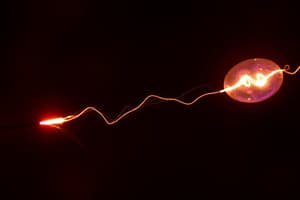Podcast
Questions and Answers
What are the two types of electric charge described in the text?
What are the two types of electric charge described in the text?
- Positive and neutral
- Protonic and neutron
- Positive and negative (correct)
- Protonic and electron
Which particle has a single unit of negative charge?
Which particle has a single unit of negative charge?
- Protons
- Positrons
- Electrons (correct)
- Neutrons
Where do protons reside within an atom?
Where do protons reside within an atom?
- With neutrons
- Protons are not part of an atom
- Around the electrons
- In the nucleus (correct)
How do separated components lead to electric charge according to the text?
How do separated components lead to electric charge according to the text?
What principle ensures that total electric charge remains constant during any process?
What principle ensures that total electric charge remains constant during any process?
Apart from atoms, where else can electric charges exist?
Apart from atoms, where else can electric charges exist?
What is the basis behind many technologies we rely upon today, such as computer chips and spacecraft propulsion systems?
What is the basis behind many technologies we rely upon today, such as computer chips and spacecraft propulsion systems?
Which type of materials allow charge to flow freely?
Which type of materials allow charge to flow freely?
What category do copper and rubber fall into, respectively, when it comes to their response to applied voltage?
What category do copper and rubber fall into, respectively, when it comes to their response to applied voltage?
Which modern technologies would likely not exist without understanding and manipulating electric charge?
Which modern technologies would likely not exist without understanding and manipulating electric charge?
Which biological function depends directly or indirectly upon electric charge, such as nerve impulse transmission within living organisms?
Which biological function depends directly or indirectly upon electric charge, such as nerve impulse transmission within living organisms?
What provides a key foundation for comprehending numerous physical phenomena and technological applications?
What provides a key foundation for comprehending numerous physical phenomena and technological applications?
Flashcards are hidden until you start studying
Study Notes
Electric Charge and Its Fundamental Nature
Electric charge is one of the most fundamental concepts underlying all interactions between matter and energy, both on our Earth and throughout the universe. Let's begin by defining electric charge, its origins, and how it contributes to shaping our world.
What Is Electric Charge?
Simply put, electric charge describes the amount of negatively charged particles called electrons or positively charged particles called protons that make up atoms. These charges can also exist separately from atoms, such as in electricity flowing through wires or lightning strikes. In short, charge has two types: positive (+) and negative (-).
Origin of Electric Charge
Atoms consist of three basic constituents: protons with a single unit of positive charge (+), neutrons which have zero charge (0), and electrons with a single unit of negative charge (-). Protons reside within the dense nucleus of an atom while electrons orbit around it. When these components become separated — either due to chemical reactions, friction, static electricity, or other processes — they result in electric charge.
Conservation of Electric Charge
One of nature's most consistent principles states that electric charge cannot simply disappear; rather, total charge always remains constant during any process. This principle ensures stability and predictability in various phenomena, including electrical circuits, chemical reactions, and natural events like thunderstorms.
Coulomb's Law and Electrostatic Forces
The French physicist Charles Coulomb developed a mathematical relationship describing the attractive or repulsive forces between charged objects known as Coulomb's law. These electrostatic forces between oppositely charged bodies grow stronger as their distance decreases, ultimately forming the basis behind many technologies we rely upon today, ranging from computer chips to satellites and spacecraft propulsion systems.
Conductors versus Insulators
Materials can generally be classified into two groups based on their response to applied voltage: conductors and insulators. Conductors allow charge to flow freely, whereas insulators do not efficiently permit this transfer of charge. Examples of common materials found in each category would be copper and rubber, respectively.
Applications and Impacts of Electric Charge
From powering devices and appliances to transmitting data across vast distances, understanding and manipulating electric charge forms the backbone of modern technology. Without it, there likely wouldn't be smartphones, computers, cars, or airplanes. Additionally, many biological functions and systems depend directly or indirectly upon electric charge, such as nerve impulse transmission within living organisms, making it a vital subject of study for biologists and medical researchers alike.
In summary, mastery of electric charge provides a key foundation for comprehending numerous physical phenomenon and technological applications. As you continue your exploration of physics and engineering fields, grasping this concept more firmly will serve to enrich your understanding of the world around us.
Studying That Suits You
Use AI to generate personalized quizzes and flashcards to suit your learning preferences.




